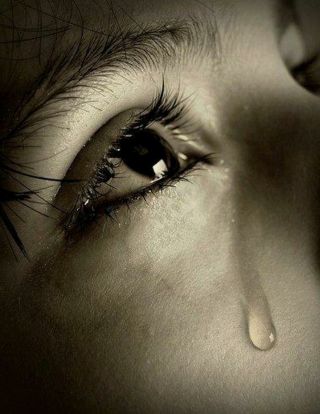Therapy
The Healing Power of Emotional Tears
Emotional tears are an expression of our shared humanity.
Posted July 29, 2024 Reviewed by Gary Drevitch

Emotional tears, expressed by children, teens, and adults, are a universal experience observed across the globe. Emotional tears play a healing role, leading to our emotional and physical well-being. This post explores the value of emotional tears and the importance of presence and support from family and friends during unexpected moments.
The Universal Language of Tears
Tears are a part of our shared humanity, emerging as a way for our bodies to release internal toxins. They are an automatic response that humans use to express suffering, compassion, empathy, and moments of generosity, awe, and joy. Tears can surface unexpectedly, whether it's a sunset, a baby's laughter, a disappointment, a loss, or a touching moment between strangers.
Tears and the Nervous System
The limbic system and the autonomic nervous system (ANS) are integral to the expression of tears. The ANS regulates functions like heart rate, breathing, and emotional responses, including crying. Emotional tears are chemically different than other kinds of tears. All tears contain enzymes, lipids, electrolytes, and metabolites. Researchers have established that crying releases oxytocin and endogenous opioids, also known as endorphins, out of our bodies. These chemicals help ease both physical and emotional pain. In other words, our bodies are always trying to be balanced, and we have a biological system working for our benefit unconsciously to stabilize our nervous systems. Magdalena Serrano, an Indigenous woman of Serrano descent, said that in the wisdom of her culture, these emotional tears are called "sweet tears." 1,2
Crying Across Cultures and Genders
Crying is beneficial, regardless of gender. Martin Trimble, a behavioral neurologist, notes that tears are a natural response to suffering and compassion. The 2024 Olympics has already showcased athletes openly expressing emotions through tears, challenging the stigma against crying, particularly for men.3
Research indicates gender differences in crying frequency. In the 1980s, biochemist William H. Frey found that women cry an average of 5.3 times per month, while men cry about 1.3 times per month. These statistics highlight societal norms and the varying acceptance of emotional expression.4,5
Emotional Support
Emotional support significantly impacts how individuals feel after crying. Bylsma (2019) revealed that crying was more likely to have a positive effect when individuals had emotional support, such as a close friend nearby. Furthermore, crying due to a positive event or leading to a resolution or new understanding of a situation also contributed to feeling better. Conversely, individuals felt worse if they were embarrassed or ashamed of crying, were with unsupportive people, or cried because they saw suffering. Overall, participants reported feeling better if they cried alone or with another supportive individual.4,5
Tears are healing in and outside of therapy. A study included 106 patients who completed a survey about crying in psychotherapy. The results showed that when patients' crying (even if painful) was followed by more positive or less negative emotions (i.e., a sense of relief), they perceived the working alliance more positively and therapeutic change was enhanced. In response to their most recent crying episode, patients' feeling of crying as a positive (albeit often painful) experience was related to a better perception of working alliance and therapeutic change.6
The Physical Sensation of Tears
Emotional tears are vital to the emotional and physical health of all people. They are part of our human GPS, indicating that we express a lived experience in tears. Not only are tears telling us something about ourselves, but they also suggest to those around us that we may need to be supported. Some of us more easily express tears than others. When we learn that our emotional tears exist to help us return to a more balanced state or represent our compassion, empathy, and awe, there can be an increased understanding that there is no shame in the expression of tears. They occur automatically. Many of us were shamed when tears came and were called names like "crybaby." Remember the beauty in your tears and their connection to your humanity. It can also be helpful to "notice tears." Noticing the wetness and the warmth of your tears can help decrease the intensity of the tears and help you feel a more embodied sense of self.7
Helping a Person With Their Tears
When you notice someone beginning to cry, assure them that it is a natural response. Reassure them that you are with them. Ask them if they can allow the tears to come and embody the tears by noticing the warmth and moisture of the tears. This will often result in a sense of relief. Encouraging and supporting the expression of tears can lead to significant emotional benefits, enhancing overall well-being.
Some mental health and physical conditions can result in a person experiencing excessive crying that impairs daily functioning and interpersonal relationships. If this occurs, seeking the help of a mental health professional may be needed. You can reach out to a therapist on Psychology Today or contact the 988 Suicide & Crisis Lifeline.
References
1. Orloff, J, Psychology Today, July 27, 2010
2. Conversation with Magdalena Serrano, LCSW, 2023
3. Martin Trimble, a Behavioral Neurologist, Interview, January 29, 2013, Scientific American.
4./5. Bylsma, L. M., Gračanin, A., & Vingerhoets, A. (2019). The neurobiology of human crying. Clinical autonomic research:official journal of the Clinical Autonomic Research Society, 29(1), 63–73. https://doi.org/10.1007/s10286-018-0526-y
6. Genova F, Zingaretti P, Gazzillo F, Tanzilli A, Lingiardi V, Katz M, Hilsenroth M. Patients' crying experiences in psychotherapy and relationship with working alliance, therapeutic change and attachment styles. Psychotherapy (Chic). 2021 Mar;58(1):160-171. doi: 10.1037/pst0000339. Epub 2020 Oct 15. PMID: 33856858.
7. Miller-Karas, E., Building Resiliency to Trauma, the Community and Trauma Resiliency Models, Second Edition, 2023, Rutledge, New York




